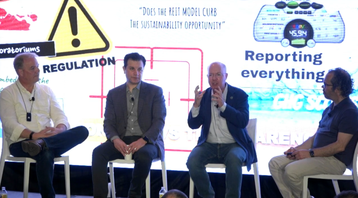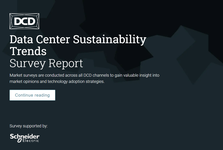These days, sustainability is at the core of our thinking in the data center industry. Whether it's the supply chain, energy, or cooling, everything spirals back down to how we can do this sustainably, so we can keep doing it for a long time to come.
In the UK today, we are in the midst of an unprecedented heatwave. 40°C (104°F), and it is a stark reminder to us Brits that the climate is getting hostile, and we are a huge contributing factor.
One of the ways we contribute is through our unrelenting reliance on connectivity, putting a huge demand on data centers and therefore on our planet. But given that this is simply the next stage of the technological revolution, how can we be embedding sustainability into our infrastructure from the get-go?
At the recent DCD>Connect Silicon Valley event, we hosted a panel discussion looking at whether we are all understanding the data center sustainability challenge in the right way and, as you can imagine, the entire globe is not exactly on the same page.
So let's go back to the beginning, or the ‘aughts’, which Dr. Arman Shehabi, a research scientist at the Lawrence Berkeley National Laboratory, describes as his first introduction to the world of data centers.
“When I first started looking at data centers, I'd walk into a data center, and there would be a few racks set up, their cooling systems were all just kind of in random places; you had hot air and cold air mixing together and it was just wildly inefficient.
“There needed to be some metrics, they needed a way to start addressing that, and that's when PUE came around. We were looking at how do we not waste this cooling electricity, because it's not providing us any service. That's improved drastically since the aughts.
“We were seeing PUE's averaging in the twos back then, and now we're in 1.2, 1.1.”
However, while PUE has proved a useful tool for improving the sustainability of data centers, it is widely agreed these days that it simply isn’t a broad enough concept. PUE, or power usage effectiveness is determined by dividing the total amount of power entering a data center by the power used to run the IT equipment within it. But sustainability is so much more than power in versus out.
“Now I think we've moved into an era where we are looking at, not just how efficiently we're using that electricity, but where that electricity is coming from. We're interested in the carbon intensity of electricity, and whether we are sourcing renewable electricity.
“As we move to the future, we're going to be expanding, so what is sustainability here? We're going to be thinking about what are the materials that are actually flowing through the data center, where they are flowing through, the location of the data center, and how much stuff's going through.”
However, the data center industry seems to really struggle to leave its perception as a power-hungry monster in the past. After a long campaign, Apple was refused permission to build in Ireland due to environmentally-motivated protests. This incident is not isolated. With the moratorium imposed by EirGrid in place until potentially 2028.
Data centers have a bad reputation. But despite this Irish moratorium, a recent DCK report found that the country’s data centers were currently only using 25 percent of their allotted power allowance.
Dean Nelson, CEO of Cato Digital & chairman & founder of Infrastructure Masons spoke on the Ireland issue further.
“Things are tense in Ireland right now for a number of different reasons, and policies are absolutely one of them. There's a shortage of energy and different things, because of policy choices, and because of a lack of investment.
“They're looking for who's consuming all that [energy]. What's interesting is that the economic opportunity that comes with building digital infrastructure in a society is huge, locally and globally.”
“For example, Loudoun County. I think Buddy Rizer was talking about this two weeks ago. And he said that the number of top tax dollars coming back into Loudoun County shed 35 cents on the dollar of the tax burden for the local people. Talk about a return for everybody there.
“At the same time, everything's been upgraded. Everything electrical, distribution of the roads, there's just tons and tons of investments that are happening.”
In other words, there needs to be a fair weighing up of pros and cons. Nelson goes on to agree that yes, the industry does use unnecessary amounts of water, but the economic value to the community should not be overlooked.
“I think at the end of it, there are ways we can solve this. But we need to be able to tell the story of the why and the impact to the people, so they're educated on what this is all about. In every one of these places we've rolled data centers into, at least from what I've seen, the economy has gotten better in that area. Why? We don't create a lot of jobs in the data center itself. But all of the second and third-tier jobs that come in, there are 1,000s and 1,000s of them.”
Sustainability needs to be considered in a wider scope, looking at every level of consumption any given industry has. Jim Connaughton, president, and CEO of Nautilus Data Technologies, and former George W. Bush administration environmental adviser talks of the approach Nautilus takes to this.
“When you take that approach, we've applied the term total resource usage effectiveness (TRUE). It's about carbon, it's also about air pollution associated with energy generation, and it's also water consumption.
“Why is a data center competing with communities for drinking water? That's nuts. Why is adata center using public wastewater infrastructure? It doesn't need to. Why is the data center using chemical refrigerants? It doesn't need to.
“Elimination of water consumption, elimination of wastewater, no chemicals, no refrigerants, no noise, that's what we should be aspiring to. It's all technologically feasible. It's all net economically positive, and it underlines the ability to leap forward and support high-performance computing.
“The sustainability conversation has to begin and end with what we are serving to our customers and to the population, and we're at this incredible fulcrum, this incredible tipping point.”
Connaughton, when it comes to the Ireland issue, is concerned that the area risks becoming a ‘flyover zone’ when it could in fact be an asset.
“The challenge in Ireland is because of the collective failure to understand the essence of the problem, which is a clean energy development problem. The challenge with the sector is that Dublin is closed. Then the question is, do you move outside of Dublin, or do you just go elsewhere? You're a little conservative data center and company end-user who can't waste any more time on Ireland. So you are going to go somewhere else. So Ireland becomes a flyover country.”
“It's because of our inability, collectively, to leap forward to a lighter footprint, and the education that Dean describes, and that's going to play itself outcommunity by community. Because it's like saying, I don't want to expand my port. That's nuts. I don't want to expand my airport. That's nuts. I don't want a bigger rail station. That's nuts. Cities grow, and they create jobs. All infrastructure creates jobs.”
Tune into the full panel for a deeper look at the sustainability challenge and its solutions




